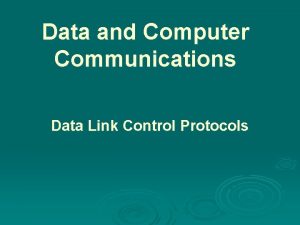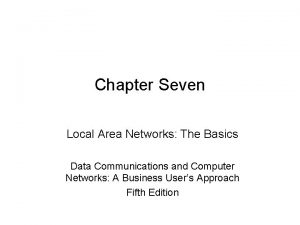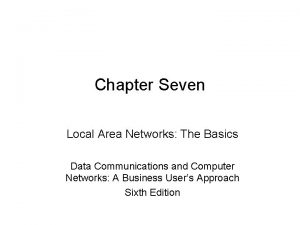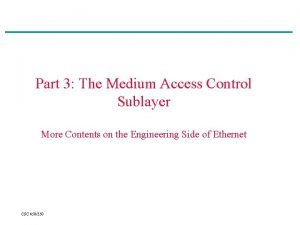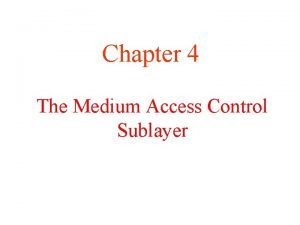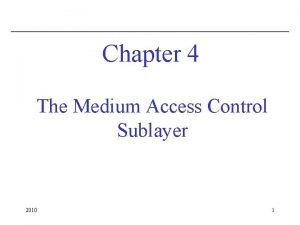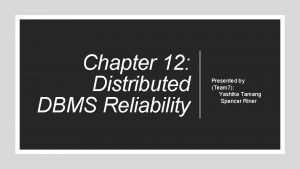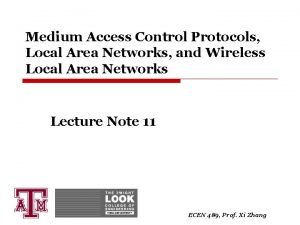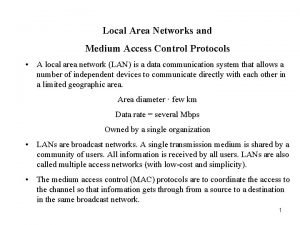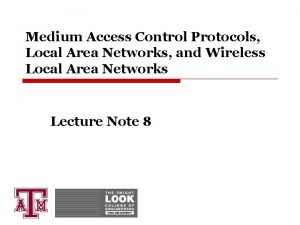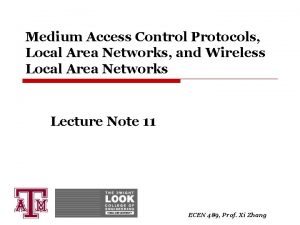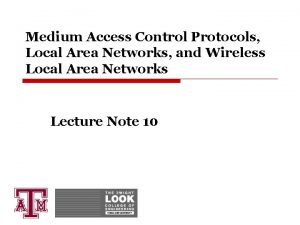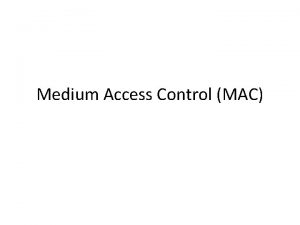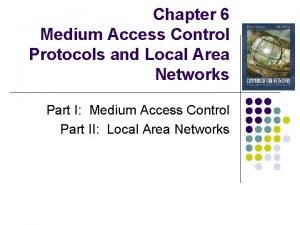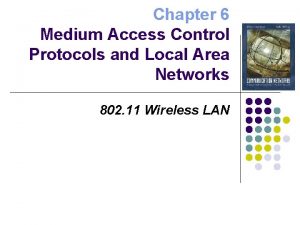Medium Access Control Protocols Local Area Networks and





![Normalized Delay versus Load E[T]/X Transfer delay E[T] = average frame transfer delay Ø Normalized Delay versus Load E[T]/X Transfer delay E[T] = average frame transfer delay Ø](https://slidetodoc.com/presentation_image/11a3d71c45f33f97527e37c58838f88e/image-6.jpg)
![Dependence on Rtprop/L a > a E[T]/X Transfer Delay a a 1 r max Dependence on Rtprop/L a > a E[T]/X Transfer Delay a a 1 r max](https://slidetodoc.com/presentation_image/11a3d71c45f33f97527e37c58838f88e/image-7.jpg)





- Slides: 12

Medium Access Control Protocols, Local Area Networks, and Wireless Local Area Networks Lecture Note 9

Medium Access Control Protocols, Local Area Networks, and Wireless Local Area Networks Part I: Medium Access Control Part II: Local Area Networks Part III: Wireless Local Area Networks

Medium Access Control Protocols, Local Area Networks, and Wireless Local Area Networks Medium Access Control Protocol Delay Performance Modeling and Analysis

Medium Access Control Protocols, Local Area Networks, and Wireless Local Area Networks Medium Access Control Protocol Throughput Performance Modeling and Analysis

MAC Delay Performance Ø Frame transfer delay From first bit of frame arrives at source MAC Ø To last bit of frame delivered at destination MAC Ø Ø Throughput Actual transfer rate through the shared medium Ø Measured in frames/sec or bits/sec Ø Ø Parameters R bits/sec & L bits/frame X=L/R seconds/frame l frames/second average arrival rate Load r = l X = X/(1/ l), rate at which “work” arrives Maximum throughput (@100% efficiency): R/L fr/sec Prof. Xi Zhang
![Normalized Delay versus Load ETX Transfer delay ET average frame transfer delay Ø Normalized Delay versus Load E[T]/X Transfer delay E[T] = average frame transfer delay Ø](https://slidetodoc.com/presentation_image/11a3d71c45f33f97527e37c58838f88e/image-6.jpg)
Normalized Delay versus Load E[T]/X Transfer delay E[T] = average frame transfer delay Ø At low arrival rate, only frame transmission time Ø At high arrival rates, increasingly longer waits to access channel Ø Max efficiency typically less than 100% X = average frame transmission time 1 Load rmax 1 r Prof. Xi Zhang
![Dependence on RtpropL a a ETX Transfer Delay a a 1 r max Dependence on Rtprop/L a > a E[T]/X Transfer Delay a a 1 r max](https://slidetodoc.com/presentation_image/11a3d71c45f33f97527e37c58838f88e/image-7.jpg)
Dependence on Rtprop/L a > a E[T]/X Transfer Delay a a 1 r max Load rmax 1 r Prof. Xi Zhang

ALOHA Wireless link to provide data transfer between main campus & remote campuses of University of Hawaii Ø Simplest solution: just do it Ø A station transmits whenever it has data to transmit If more than one frames are transmitted, they interfere with each other (collide) and are lost Ø If ACK not received within timeout, then a station picks random backoff time (to avoid repeated collision) Ø Station retransmits frame after backoff time Ø Ø First transmission t 0 -X t 0 Backoff period B Retransmission t t 0+X Vulnerable period t 0+X+2 tprop + B Time-out Prof. Xi Zhang

ALOHA Model Ø Definitions and assumptions Ø X frame transmission time (assume constant) Ø S: throughput (average # successful frame transmissions per X seconds) Ø G: load (average # transmission attempts per X sec. ) Ø Psuccess : probability a frame transmission is successful X Prior interval X frame transmission Ø Any transmission that begins during vulnerable period leads to collision Ø Success if no arrivals during 2 X seconds Prof. Xi Zhang

Abramson’s Assumption Ø What is probability of no arrivals in vulnerable period? Ø Abramson assumption: Effect of backoff algorithm is that frame arrivals are equally likely to occur at any time interval Ø G is avg. # arrivals per X seconds Ø Divide X into n intervals of duration D=X/n Ø p = probability of arrival in D interval, then G=np since there are n intervals in X seconds Prof. Xi Zhang

Throughput of Pure ALOHA Ø Collisions are means for coordinating access Ø Max throughput is rmax= 1/2 e (18. 4%) Ø Bimodal behavior: 0. 5 e-1 = 0. 184 Small G, S≈G Large G, S↓ 0 Ø Collisions can snowball and drop throughput to zero Prof. Xi Zhang

Slotted ALOHA Time is slotted in X seconds slots Stations synchronized to frame times Stations transmit frames in first slot after frame arrival Ø Backoff intervals in multiples of slots Ø Ø Ø Backoff period k. X (k+1)X Vulnerabl eperiod t 0 +X+2 tprop B t t 0 +X+2 tprop+ B Time-out Only frames that arrive during prior X seconds collide Prof. Xi Zhang
 Flow control protocols
Flow control protocols Hdlc operation
Hdlc operation Protocols and standards in computer networks
Protocols and standards in computer networks What are the basic layouts of local area networks
What are the basic layouts of local area networks What are the basic layouts of local area networks
What are the basic layouts of local area networks Fixed tdm in mobile computing
Fixed tdm in mobile computing Medium access control sublayer
Medium access control sublayer Media acces control
Media acces control Media access control sublayer
Media access control sublayer Data link layer design issues in computer networks
Data link layer design issues in computer networks Elementary data link protocols in computer networks
Elementary data link protocols in computer networks Lgs protocols
Lgs protocols Distributed reliability protocols
Distributed reliability protocols

